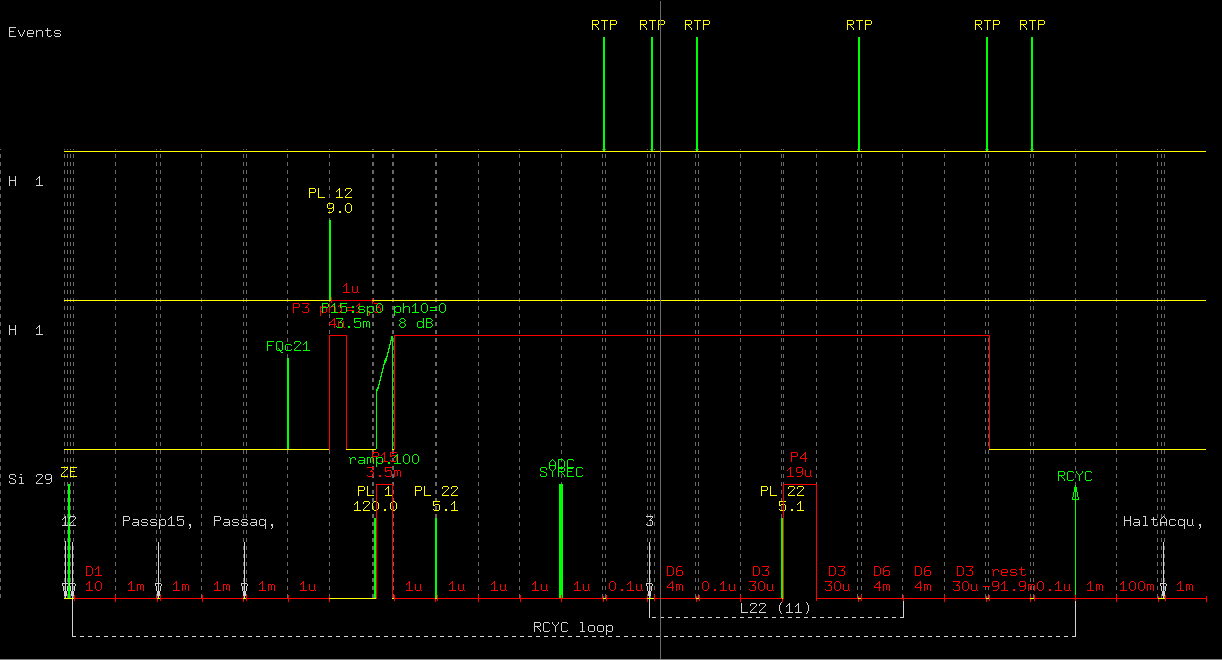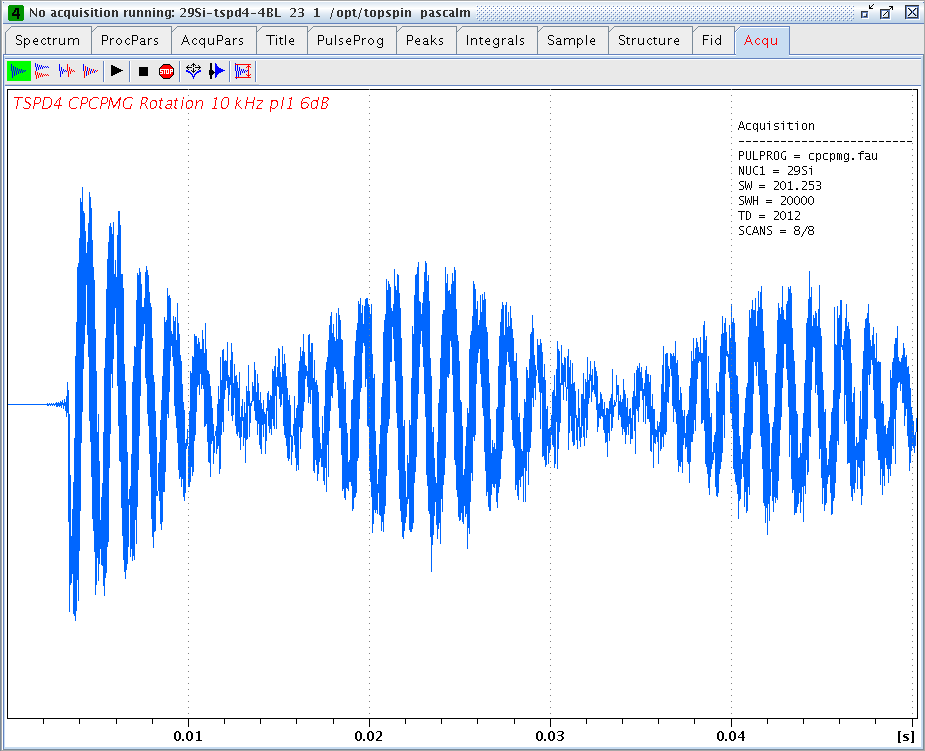
CP-CPMG pulse program for topSpin2.1 operating system

;cpcpmg.fau (TopSpin 2.1 pl3)
;cp experiment with CPMG detection
;written by FAU 08.01.2009
;use rotor-synchronized CPMG train of refocusing pulses to create the echoes
;Avance III version
;parameters:
;p3 : proton 90 at power level pl12
;p4 : 180 degree pulse at pl22
;p15 : contact time at pl1 (f1) and sp0 (f2)
;pl1 : X power level during contact
;sp0 : proton power level during contact
; sp0 is the max power level during shape pulse
;pl2 : =120dB, not used
;pl12 : decoupling power level (if not pl13)
;pl13 : special decoupling power level
;pl22 : rf power level
;d1 : recycle delay
;d3 : time to allow pulse ringdown, 10 to 100 us
;d6 : duration of FID
;pcpd2 : pulse duration in decoupling sequence (for tppm15, ~(170/90)*90° pulse duration)
;cpdprg2 : cw, tppm (at pl12), or
; lgs, cwlg. cwlgs (LG-decoupling, here pl13 is used instead of pl12)
;spnam0 : use e.g. ramp.100 for variable amplitude CP
;zgoptns : -Dfslg, -Dlacq, or blank
;p25 : dummy pulse, not used for acq.
;l22 : # of echos to be acquired
;cnst1 : set td to number of acquired complex data points, td=cnst1
;cnst21 : on resonance, usually = 0
;$COMMENT=cp experiment with CPMG detection
;$CLASS=Solids
;$DIM=1D
;$TYPE=cross polarisation
;$SUBTYPE=simple 1D
;$OWNER=Bruker
prosol relations=<solids_cp>
#include <Avancesolids.incl> ;commands necessary for acquisition
#ifdef fslg
#include <lgcalc.incl>
;cnst20 : RF field achieved at pl13
;cnst21 : on resonance, usually = 0
;cnst22 : positive LG offset
;cnst23 : negative LG offset
;cnst24 : additional LG-offset
#endif /* fslg */
"cnst1=((d6*2+d3*2+p4)*l22+d6+d3)/dw"
define delay rest
"rest=aq-(cnst1*dw)"
"p25=1/cnst1"
;cnst11 : to adjust t=0 for acquisition, if digmod = baseopt
"acqt0=1u*cnst11"
1 ze
2 d1 do:f2 ;recycle delay, decoupling off
#include <p15_prot.incl>
;make sure p15 does not exceed 10 msec
;let supervisor change this pulseprogram if
;more is needed
#ifndef lacq
;disable protection file for long acquisition change decoupling power!!!
;or you risk probe damage
;if you set the label lacq (ZGOPTNS -Dlacq), the protection is disabled
#include <aq_prot.incl>
;allows max. 50 msec acquisition time, supervisor
;may change to max. 1s at less than 5% duty cycle
;and reduced decoupling field
#endif /* lacq */
1u fq=cnst21:f2 ;used in tppm15 for example
;if cnst21=0, make sure cp is done with proton freq
;set by O2
(p3 ph1):f2 (1u pl12):f2 ;proton 90° pulse
(p15 pl1 ph2):f1 (p15:sp0 ph10):f2 ;use square.100 or ramp.100 shape for sp0
;in proton channel F2
1u cpds2:f2 ;select appropriate decoupling sequence, switch on
;cw or tppm15 decoupling executed at power level pl12
;or LG-decoupling executed at power level pl13
1u pl22:f1 ;set 180° pulse power level
STARTADC ;arm adc
RESETPHASE ;reset reference phase for detection
0.1u DWL_CLK_ON
3 d6 RG_ON
0.1u RG_OFF
d3
(p4 pl22 ph3):f1
d3
d6 RG_ON
lo to 3 times l22
d6
d3
rest RG_OFF do:f2 ;set decoupling off
0.1u DWL_CLK_OFF
rcyc=2 ;loop NS times
1m do:f2 ;set decoupling off
100m wr #0 ;write signal
HaltAcqu, 1m ;jump address for protection
exit
ph0= 0
ph1= 1 3
ph2= 0 0 2 2 1 1 3 3
ph3= 0 0 2 2 1 1 3 3
ph10=0
ph30=0
ph31=0 2 2 0 1 3 3 1

Graphic representation associated with the TopSpin2.1 cpcpmg.fau pulse program.

29Si echo train of TSP-d4 in 4-mm diameter rotor spinning at 10 kHz. A contact duration P15 = 8 ms increases the amplitude of the echo train by two.
Acquisition parameters:
| General | |
| PULPROG | cpcpmg.fau |
| TD | 7644 |
| NS | 1920 |
| DS | 0 |
| SWH [Hz] | 20000.00 |
| AQ [s] | 0.1911500 |
| RG | 114 |
| DW [µs] | 25.000 |
| DE [µs] | 6.50 |
| const1 | 7642.463867 |
| CONST11 | 0.0000000 |
| D1 [s] | 30.00000000 |
| D3 [s] | 0.00005000 |
| D6 [s] | 0.01000000 |
| L22 | 9 |
| P25 [µs] | 0.00 |
| ZGOPTNS | -Dlacq |
| rest [s] | 0.00008840 |
| Channel f1 | |
| NUC1 | 29Si |
| P15 [µs] | 4000.00 |
| P4 [µs] | 12.40 |
| PL1 [dB] | 6.00 |
| PL1W [W] | 130.4819793 |
| PL22 [dB] | 6.00 |
| PL22W [W] | 130.4819793 |
| SFO1 [MHz] | 99.3774009 |
| Channel f2 | |
| CNST21 | 0.00000000 |
| CPDPRG2 | tppm15 |
| NUC2 | 1H |
| P3 [µs] | 11.00 |
| PCPD2 [µs] | 20.70 |
| PL2 [dB] | 120.00 |
| PL2W [W] | 0.00000000 |
| PL12 [dB] | 16.00 |
| PL12W [W] | 8.05732536 |
| SFO2 [MHz] | 500.2113720 |
| SP0 [dB] | 10.00 |
| SP0W [W] | 32.07678986 |
| SPNAM0 | ramp.100 |
| SPOAL0 | 0.500 |
| SPOFFS0 [Hz] | 0.00 |

29Si echo train of TSP-d4 in 4-mm diameter rotor spinning at 10 kHz, NS = 8, and decoupling with PL12 = 16 dB

29Si echo train of TSP-d4 in 4-mm diameter rotor spinning at 10 kHz, NS = 8, and decoupling with PL12 = 10 dB